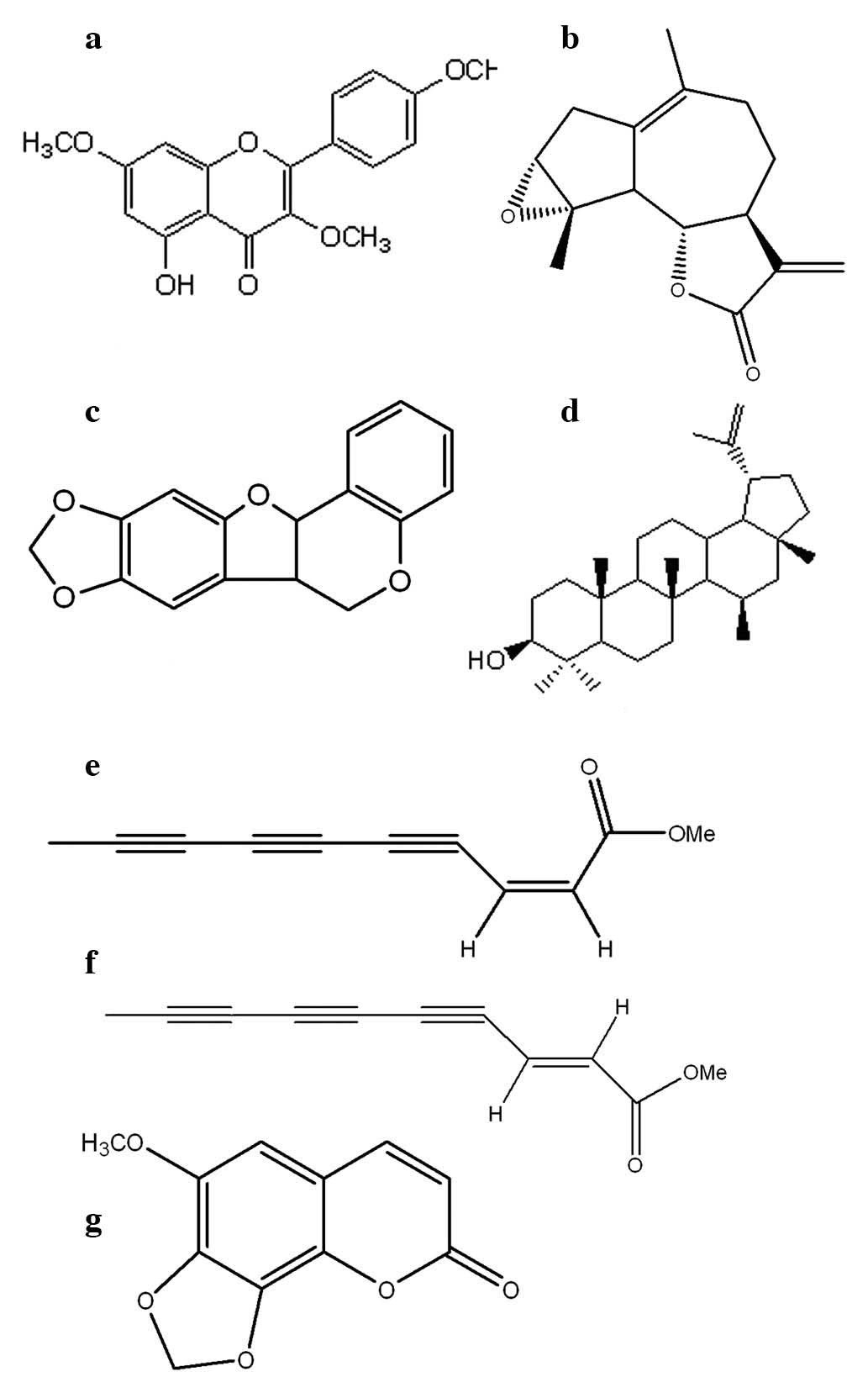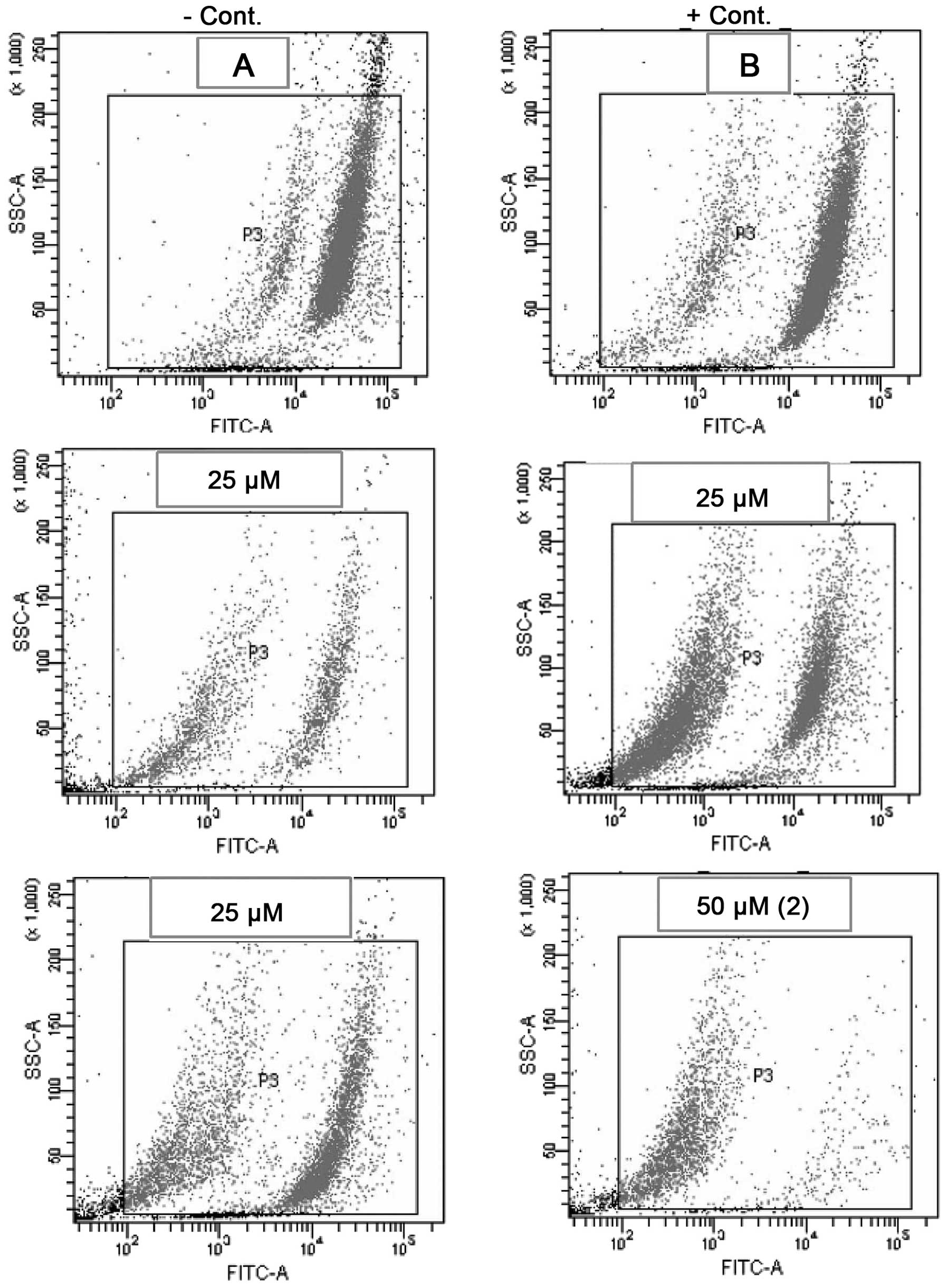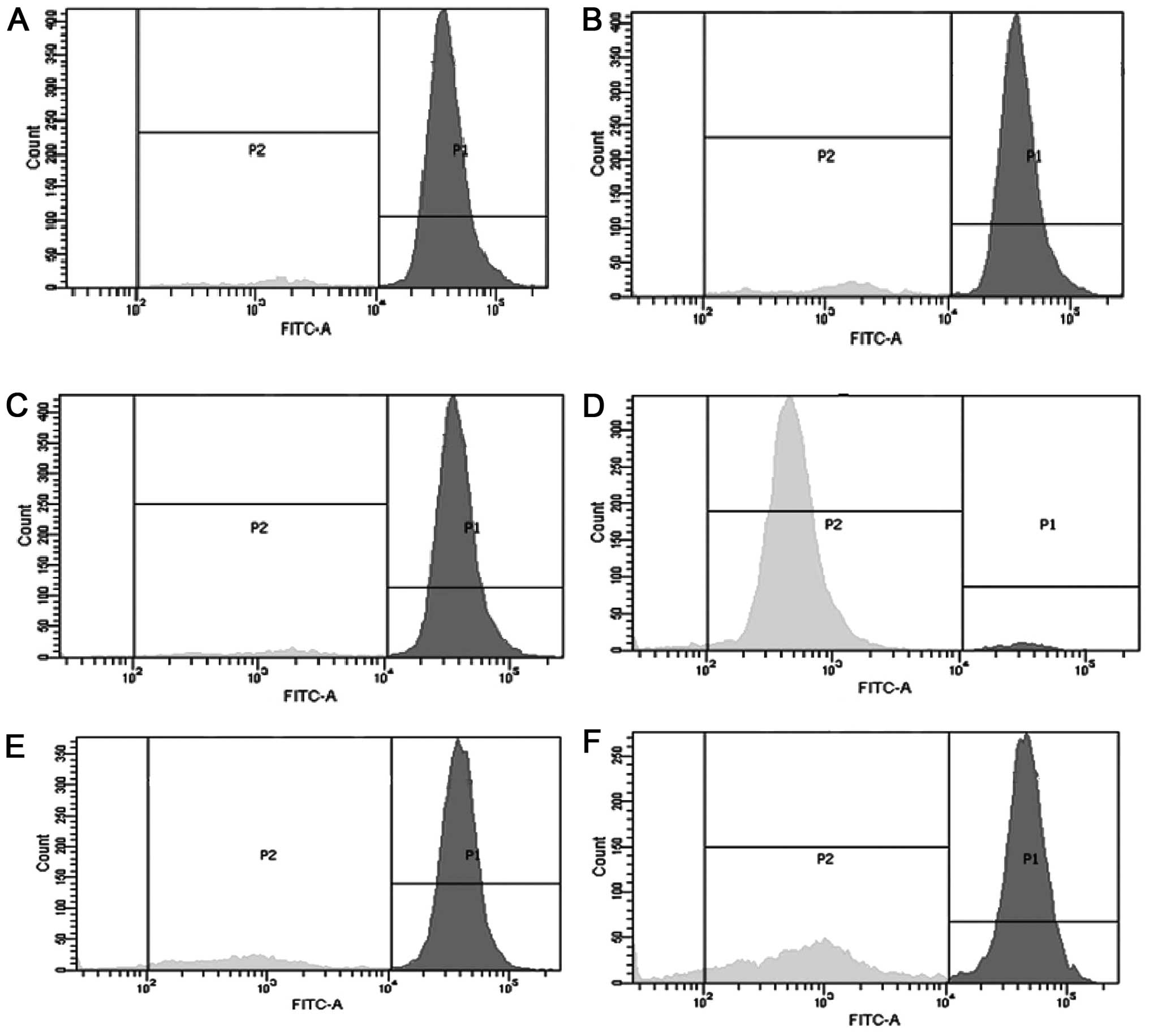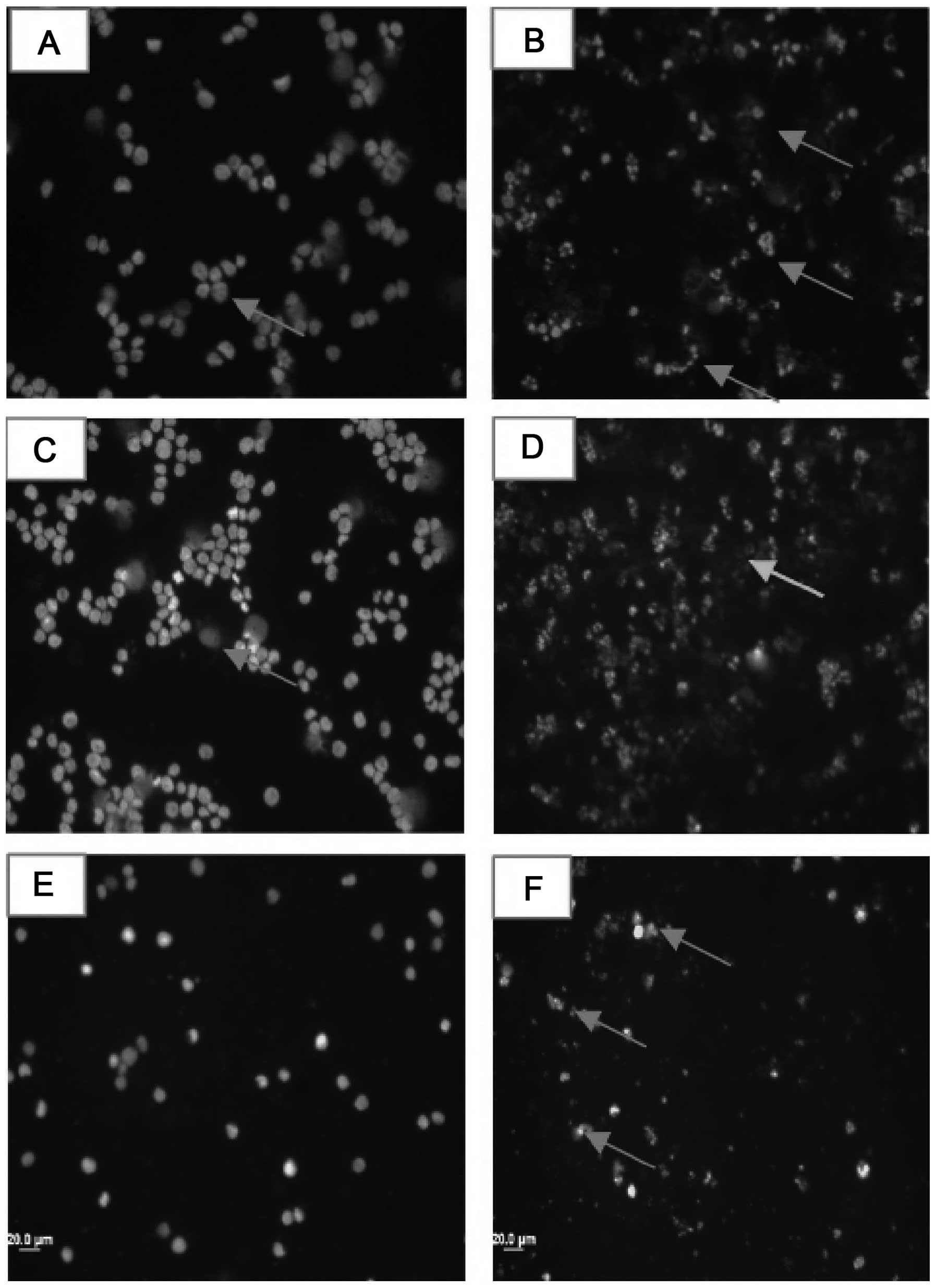Antitumor and apoptotic activities of the chemical constituents from the ethyl acetate extract of Artemisia indica
- Authors:
- Published online on: November 27, 2014 https://doi.org/10.3892/mmr.2014.3012
- Pages: 2234-2240
Abstract
Introduction
As reported by the World Health Organization (WHO), >50% of the global population use traditional medicines for the prevention and treatment of diseases (1). This is primarily due to the high cost of western medicines. Traditional medicine largely consists of the use of plant extracts. The discovery of numerous effective anticancer agents from plants may be credited, directly or indirectly, to a history of use of the relevant plants in traditional medicine. The first plant-derived agents to advance into clinical use, the vinca alkaloids vinblastine and vincristine, were isolated from the Madagascar periwinkle (Catharanthus roseus G.Don), and are used in various cultures. Natural products, of which the majority are plant-derived molecules, have become an increasingly vital source of potent anticancer agents, which have been demonstrated to be more effective and/or less toxic than synthetic alternatives (2). Natural products may become vital in the future for anticancer drug discovery, as they are a potential source of compounds of vast structural diversity and have been previously comprehensively explored in the field of drug discovery, leading to great successes. The majority of these were in the field of cancer therapeutics, in which >60% of the approved drugs discovered in recent decades have been obtained from a natural origin. Numerous commonly applied anticancer agents, such as vincristine, irinotecan, etoposide and paclitaxel, which represent a range of structurally diverse anticancer drugs, are all plant-derived and are vital components of chemotherapy (1–6).
Cancer is the second most common cause of mortality worldwide, with a yearly increasing mortality rate despite extensive research dedicated to the development of novel treatment and prevention strategies (9). Cancer develops through a multistep carcinogenesis process that encompasses various cellular physiological systems, such as cell signalling and apoptosis, thus making it a very complex disease. The majority of currently used anticancer drugs, which have been obtained by synthesis of novel compounds or are from natural sources, are toxic to normal cells in addition to cancer cells and thus have substantial harmful side effects. There is therefore a continuous search for innovative chemotherapeutic drugs that act as ‘magic bullets’, specifically targeting cancer cells with minimal damage to normal cells (10). This ideal situation may be achievable by the induction of apoptosis in cancer cells. Thus, apoptosis modulation may be a key factor in the prevention and treatment of cancer. Recently, apoptosis induction in cancer cells has been the focus for an innovative mechanism upon which to base drug discovery (11–13). Apoptosis is a mechanism of programmed cell death that is characterized by highly organized biochemical processes that eradicate injured or abnormal cells. Apoptosis serves a key function as a protective mechanism against cancer, by removing genetically damaged cells, or cells that have become cancerous. When apoptosis is triggered in response to certain physiological signals, a proteolytic cascade involving different caspases is initiated in the suicidal cell. This cascade this leads to activation of nucleases that initiate the degradation of chromosomal DNA. This type of DNA fragmentation is considered a hallmark of the apoptotic process (14,15).
Artemisia indica Willd. (of the family Asteraceae) is a perennial herb that is indigenous to the western Himalayas and China. It has traditionally been employed to ameliorate chronic fever, dyspepsia and hepatobiliary ailments. The leaves and flowering stems of A. indica have been reported to be antihelminthic, antiseptic and antispasmodic. A previous phytochemical study has led to the isolation of antimalarial phytoconstituents from the crude methanol extract of A. indica, including exiguaflavanone-A, exiguaflavanone-B, maacklain and 2-(2,4-dihydroxyphenyl)-5,6-methylenedioxy benzofuran (16,17).
Materials and methods
Plant material, preparation of extracts and chromatography
The shade-dried aerial section of the Artemisia indica plant (3.0 kg) collected from a local region of Gansu, China (Specimen number: GNS-762) was subjected to chloroform extraction three times. The solvent was evaporated in vacuo to obtain a crude extract of 300 g. The obtained extract was subjected to column chromatography over a silica-gel to obtain compounds a (700 mg), b (2.1 g) and c (100 mg) using hexane-EtOAc (Guoyao Chemical Co., Ltd., Shanghai, China) as an eluent with increasing polarity of 20, 25 and 35%, respectively. Similarly, the root section (1.5 kg) was shade-dried and macerated with CHCl3 (Guoyao Chemical Co., Ltd.) to yield 100 g crude extract, which upon fractionation, produced fraction I (7.4 g), II (13.2 g) and III (17.3 g) with 10, 20 and 50% EtOAc, respectively. Repeated column chromatography of fraction I yielded three more compounds: D (50 mg), e (65 mg) and f (2.5 g), fraction II and III yielded c (200 mg; also isolated from the shoot) and g (10.0 mg), respectively. A number of the compounds were purified by re-crystallization. The isolated compounds were characterized by spectral techniques, such as 1nuclear magnetic resonance (NMR), 13Carbon (C)-NMR, distortionless enhancement by polarization transfer (DEPT)-NMR (all using a Bruker AV III NM Spectrometer; Bruker Scientific Technology Co., Ltd., Beijing, China) and liquid chromatography–mass spectrometry (LC-MS) using an Agilent 1200 system (Agilent Technologies, Waldbronn, Germany) coupled with a Bruker micro QTOF mass spectrometer (Bruker Daltonics, Ettlingen, Germany).
Chemicals used for cytotoxicity assay
Growth medium RPMI-1640, minimum essential medium and fetal calf serum (FCS) were obtained from Gibco-BRL (Carlsbad, CA, USA) and trypsin, penicillin, MTT, streptomycin, dimethylsulfoxide (DMSO) and phosphate-buffered saline (PBS) were obtained from Tianjin Hanyang Biologicals Technology Co. Ltd. (Tianjin, China).
Cell lines
MCF-7 human breast cancer, BHY human oral squamous carcinoma, Miapaca-2 human pancreatic cancer, Colo-205 human colon cancer, A-549 human lung cancer cell lines and NIH-3T3 mouse embryonic fibroblasts were procured from the Institute of Cancer Research (Gansu, China). All cells were grown in a humidified incubator with 5% CO2 atmosphere at 37°C and cultured in RPMI-1640 medium supplemented with 10% heat-inactivated FCS, 100 IU/ml penicillin and 100 μg/ml streptomycin.
Antiproliferative assay
Serial dilutions of the compounds (10–100 μM) were prepared by dissolving them in DMSO. The cell cytotoxicity was determined in MCF-7, BHY, Miapaca-2, Colo-205, A-549 and BHY cells using MTT assay, and the the half maximal inhibitory concentration values (IC50) were calculated. The cells were plated in 96-well plates and treated with different concentrations of the seven compounds. Subsequent to incubation for 24, 48 and 72 h at 37°C in a humidified incubator, MTT (5 mg/ml) was added to each well followed by incubation for a further 4 h. The medium was carefully removed, then 0.2 ml DMSO was added to each well and the plates were agitated to allow for mixing. The absorbance was measured at 545 nm. The inhibitory effect of the compounds on cell growth was assessed as the percentage cell cytotoxicity, where vehicle-treated cells were considered to be 100% viable. The final concentration of DMSO was 0.5% in all treatment protocols.
Flow cytometric analysis
Cell cycle analysis
MCF-7 cells (5×105) were seeded in 60-mm dishes and treated with two concentrations (25 and 50 μM) of compounds b and d, for 48 h. Floating and adherent cells were collected by trypsinization and washed once with PBS. Cells were incubated in 70% ethanol at −20°C overnight, treated with 20 μg/ml RNase A, then stained with 1.0 μg/ml propidium iodide (PI). The stained cells were analyzed by flow cytometry using a FACS Calibur instrument (BD Biosciences, San Jose, CA, USA) at a wavelength of 488 nm. The data were acquired using CellQuest Pro Acquisition software version 3.3 (BD Biosciences).
Measurement of mitochondrial membrane potential (ΛΨm)
ΛΨm was measured by Rhodamine-123 (Rh-123) dye (Tianjin Hanyang Biologicals Technology Co., Ltd.). Briefly, 5×105/ml MCF-7 cells were treated with different concentrations (25 and 50 μM) of compound b and d and ΛΨm was measured by flow cytometry. Rh-123 (1 mM) was added 1 h prior to the termination of experiment. The cells were collected, washed in PBS and incubated with PI (5 μg/ml) for 20 min. The reduction in fluorescence intensity, as a result of ΛΨm loss was analyzed in the FL-1 channel.
Fluorescence microscopy
Fluorescence microscopy was performed to evaluate the morphological alterations on the cells following drug treatment. Cells (1×106 cells/ml) were seeded in 6-well plates and treated with the tested compounds at 25 and 50 μM. After 24 h, cells were spun at 1000 × g for 5 min. The pellet was resuspended in PBS. Cells were stained with DAPI (Guoyao Chemical Co., Ltd.). Cells were then observed, and images were captured, under a phase contrast microscope (Nikon TMS, Nikon Corporation, Tokyo Japan) for morphological analysis. Fluorescence-based dyes were employed for staining the cellular components.
Statistical analysis
IC50 values were calculated by non-linear regression analysis with Graph Pad Prism, version 5.0 (GraphPad Software, Inc., La Jolla, CA, USA). Values are expressed as the means ± standard error of at least three independent experiments. A P<0.05 was considered to indicate a statistically significant difference.
Results
Isolation and structure elucidation of the compounds
The seven compounds (a–g) were obtained from shoot and root extract of A. indica. Their structures are presented in Fig. 1, and the molecules were identified as (a) 5-hydroxy-3,7,4′-trimethoxyflavone, (b) ludartin, (c) maackiain, (d) lupeol, (e) cis-matricaria ester, (f) trans-matricaria ester and (g) 6-methoxy-7,8-methylenedioxy coumarin, by comparison of spectroscopic [1D-NMR, 2D-NMR, infrared spectroscopy (IR), and high resolution (HR)-MS] and analytical data comparison with previous literature (18–28). The majority of the compounds were isolated from A. indica for the first time in the current study, to the best of our knowledge, with the exception of maackiain, which has been reported previously (16). A number of the isolated compounds have previously only been isolated from other species of the genus Artemisia (29–32).
Antitumor activity
The isolated compounds (a–g) were evaluated for antiproliferative activity by MTT assay against the human cancer cell lines, MCF-7, BHY, Miapaca-2, Colo-205 and A-549, and a normal mouse embryonic fibroblast cell line NIH-3T3 at 24, 48 and 72 h following treatment with the compounds. All of the compounds exhibited cytotoxic activity in a dose-dependent manner at different time intervals with a maximum effect at 72 h. The antiproliferative effect obtained as a result of 72-h treatment and the IC50 data are summarized in Table I. Among the seven compounds, compounds b and d exhibited the greatest antiproliferative effect against all the cell lines. The IC50 values were 25.18 and 28.09 (MCF-7); 28.05 and 32.31 (BHY); 31.21 and 36.45 (Miapaca-2); and 34.33 and 39.01 μM (Colo-205) for compounds b and d, respectively. The MCF-7 cell line was the most susceptible to these two compounds. Furthermore, the cytotoxic effects of the compounds (a–g) were evaluated against NIH-3T3 mouse embryonic fibroblasts. This was performed in order to provide further insight into whether these compounds are specific or non-specific to cancer cells. The normal cells were treated with the IC50 equivalent concentrations of the compounds. Table II lists the cytotoxicity data of compounds a–g in the normal cell line. The data shows that these compounds also exhibit cytotoxic effects towards the normal cell lines, which in this case are NIH 3T3 mouse embryonic fibroblasts. The results demonstrate that compounds b and d exhibited lower toxicity towards the normal cell lines. This implies that these compounds show specific cytotoxic effect towards cancer cell lines.
Table ICytotoxic effects of the extract and the isolated compounds (a–g) of A. indica against the four cell lines. |
Effect of compounds b and d on DNA damage and cell cycle phase distribution
The effect of compounds b and d on cell cycle phase distribution was analyzed by flow cytometry. The MCF-7 cells were stained with PI and then treated with different concentrations (25 and 50 μM) of the compounds for 72 h. Significant DNA damage was indicated by the fluorescence patterns obtained from the flow cytometer (Fig. 2). Apoptotic cells were designated as shrunken cells with degraded chromatin, high side scatter and low forward scatter properties. The rise in the sub-G1 cell population (hypodiploid DNA content) may be due to DNA fragmentation, which results in apoptotic cell death. The inhibition of cell cycle progression may be one of the molecular events concomitant with the cytotoxic activity of these compounds.
Effect of compounds b and d on ΛΨm
The effect of compounds b and d were further studied by evaluating their effects on the ΛΨm. MCF-7 cells were treated with 25 and 50 μM compound b and d and ΛΨm was measured by flow cytometry. The untreated control cells had intact mitochondria, and the majority of the cells were bioenergetically active, as evidenced by high Rh-123 uptake as compared with the positive control, which exhibited damaged mitochondria. The two compounds induced a significant increase in mitochondrial membrane potential loss. Ludartin (compound d) produced a more potent effect on the mitochondrial membrane potential loss as compared with lupeol (compound b) (Fig. 3). Mitochondria have a key function in the induction of apoptosis, as they are involved at an early period in the apoptotic pathway. Mitochondrial membrane potential is crucial in the regulation of apoptosis, and any reduction leads to increased mitochondrial penetrability and the opening of the permeability transition pore, which is a key stage in apoptosis (33). The opening of the permeability transition pore permits the release of factors such as cytochrome c and apoptotic inducing factor, which trigger the finishing and degradative stage of apoptosis.
Fluorescence microscopy
The MCF-7 cells were treated with compound b and d for 24 h, stained with DAPI and visualized to determine the resulting morphological alterations. The untreated cells displayed a normal nuclear morphology, but ludartin- and lupeol-treated cells presented apoptotic bodies. The number of apoptotic bodies was greater at a higher dose. Camptothecin, which is a known apoptotic inducer, was used as a positive control and also led to the appearance of typical apoptotic bodies (Fig. 4).
Discussion
Cancer is a multi-factorial disease that commonly presents numerous complications, and requires a holistic approach to treatment, control and prevention. Cancer develops via a multistep carcinogenesis progression involving a number of cellular physiological systems, such as cell signaling and apoptosis, making it a very complex disease (11). Cancer is the second most prominent cause of mortality worldwide. According to global cancer statistics from 2011, cancer rates are increasing at an alarming rate (13). Plant extracts have often been used for the prevention and treatment of human diseases, including cancer. The Artemisia species have well-established chemical and pharmacological properties, and have been used traditionally for the treatment of hepatitis, cancer, inflammation and fungi, bacteria and virus infections. Numerous bioactive compounds that exhibit antimalarial and anticancer (34) activity against tumor cells, such as artemisinin, have been reported to be of the Artemisia genus, and arglabin, another bioactive molecule is used for treating certain types of cancer (35,36). The present study, is the first study on the antiproliferative and apoptotic effects of the chemical constituents of A. indica, to the best of our knowledge.
The effects of the isolated compounds a–g on MCF-7, BHY, Miapaca-2, Colo-205 and A-549 cell lines were investigated by MTT assay. As indicated in Table I, of the seven tested compounds, compounds b and d were identified to have the strongest antiproliferative activities against all of the cell lines. The IC50 values were 25.18 and 28.01 (MCF-7); 28.05 and 32.31 (BHY); 31.21 and 36.45 (Miapaca-2); and 35.12 and 39.01 μM (Colo-205) for compounds b and d, respectively. On the basis of the IC50 values and cytotoxicity data (Table I and II), the effect of compounds b and d on DNA damage and mitochondrial membrane potential loss in MCF-7 cells was investigated. The aim was to determine the mechanisms by which these compounds exert their cytotoxic effects. Flow cytometry was used to verify apoptosis induction in MCF-7 cells following 48-h incubation with compounds b and d at their IC50 concentrations. As presented in the figures, the two compounds induced significant DNA damage and reduction of ΛΨm at 25 and 50 μM concentrations.
In summary, the current bioactivity-guided isolations led to the conclusion that the strong inhibitory effect of the ethyl acetate extract of A. indica on the proliferation of the cultured human tumor cell lines MCF-7, BHY, Miapaca-2, Colo-205 and A-549 may be attributed to ludartin (4) and lupeol (6). However, a favorable interaction between the chemicals may be responsible for the overall antiproliferative action of the extract. The present study also demonstrated that the antiproliferative effects of compounds b and d as anticancer agents may be due to the significant DNA damage and mitochondrial membrane potential loss induced by these compounds. Further studies are required to fully evaluate these underlying mechanisms of action and the toxicity of the compounds, prior to further development as potent anticancer agents.
Acknowledgements
The authors would like to acknowledge the funding from Guangdong Hospital Pharmacy Research Foundation (nos. 2011A17 and 2013YY02).
References
|
World Health Organization. Promoting the role of traditional medicine in health systems: a strategy for the African region 2001–2010. Harare: World Health Organization; 2000 | |
|
Li JW and Vederas JC: Drug discovery and natural products: end of an era or an endless frontier? Science. 325:161–165. 2009. View Article : Google Scholar : PubMed/NCBI | |
|
Ma X and Wang Z: Anticancer drug discovery in the future: an evolutionary perspective. Drug Discov Today. 14:1136–1142. 2009. View Article : Google Scholar : PubMed/NCBI | |
|
Gordaliza M: Natural products as leads to anticancer drugs. Clin Transl Oncol. 9:767–776. 2007. View Article : Google Scholar : PubMed/NCBI | |
|
Madhuri S and Pandey G: Some anticancer medicinal plants of foreign origin. Curr Sci India. 96:779–783. 2009. | |
|
Harvey AL: Medicines from nature: are natural products still relevant to drug discovery? Trends Pharmacol Sci. 20:196–198. 1999. View Article : Google Scholar : PubMed/NCBI | |
|
Newman DJ, Cragg GM and Snader KM: The influence of natural products upon drug discovery. Nat Prod Rep. 17:215–234. 2000. View Article : Google Scholar : PubMed/NCBI | |
|
Mann J: Natural products in cancer chemotherapy: past, present and future. Nat Rev Cancer. 2:143–148. 2002. View Article : Google Scholar | |
|
Bray F, Ren JS, Masuyer E and Ferlay J: Global estimates of cancer prevalence for 27 sites in the adult population in 2008. Int J Cancer. 132:1133–1145. 2013. View Article : Google Scholar | |
|
Saleem K, Wani W, Haque A, Milhotra A and Ali I: Nanodrugs: magic bullets in cancer chemotherapy. Topics in Anti-Cancer Research. 2. Bentham Science Publishers; pp. 437–494 | |
|
Reichert JM and Wenger JB: Development trends for new cancer therapeutics and vaccines. Drug Discov Today. 13:30–37. 2008. View Article : Google Scholar : PubMed/NCBI | |
|
Carnesecchi S, Schneider Y, Ceraline J, et al: Geraniol, a component of plant essential oils, inhibits growth and polyamine biosynthesis in human colon cancer cells. J Pharmacol Exp Ther. 298:197–200. 2001.PubMed/NCBI | |
|
Jemal A, Bray F, Center MM, et al: Global cancer statistics. CA Cancer J Clin. 61:69–90. 2011. View Article : Google Scholar : PubMed/NCBI | |
|
Gibbs JB: Mechanism-based target identification and drug discovery in cancer research. Science. 287:1969–1973. 2000. View Article : Google Scholar : PubMed/NCBI | |
|
Debatin KM: Apoptosis pathways in cancer and cancer therapy. Cancer Immunol Immunother. 53:153–159. 2004. View Article : Google Scholar : PubMed/NCBI | |
|
Chanphen R, Thebtaranonth Y, Wanauppathamkul S and Yuthavong Y: Antimalarial principles from Artemisia indica. J Nat Prod. 61:1146–1147. 1998. View Article : Google Scholar : PubMed/NCBI | |
|
Rashid S, Rather MA, Shah WA and Bhat BA: Chemical composition, antimicrobial, cytotoxic and antioxidant activities of the essential oil of Artemisia indica Willd. Food Chem. 138:693–700. 2013. View Article : Google Scholar | |
|
Blunt JW and Stothers JB: 13C-NMR-spectra of steroids - A survey and commentary. Org Magn Resonance. 9:439–464. 1977. View Article : Google Scholar | |
|
Abraham RJ and Monasterios JR: 13C nuclear magnetic resonance spectra of some ergosta-dienes and -trienes. J Chem Soc Perkin Trans. 2:662–665. 1974. View Article : Google Scholar | |
|
Geissman TA and Griffin TS: Sesquiterpene lactones of Artemisia carruthii. Phytochemistry. 11:833–835. 1972. View Article : Google Scholar | |
|
Sosa VE, Oberti JC, Gil RR, et al: 10-Epideoxycumambrin b and other constituents of Stevia yaconensis var. subeglandulosa. Phytochemistry. 28:1925–1929. 1989. View Article : Google Scholar | |
|
Harborne J, Tomás-Barberán F, Williams C and Gill M: A chemotaxonomic study of flavonoids from european teucrium species. Phytochemistry. 25:2811–2816. 1986. View Article : Google Scholar | |
|
Bohlmann F and Rode KM: Polyacetylene, CVIII. About the ingredients of Artemisia pedemontana Balb. Chem Ber. 99:2416–2418. 1966.(In German). View Article : Google Scholar | |
|
Bohlmann F, Burkhardt T and Zdero C: Naturally Occurring Polyacetylenes. Academic Press; London: pp. 5471973 | |
|
Kobayashi A, Morimoto S, Shibata Y, Yamashita K and Numata M: C-10 polyacetylenes as allelopathic substances in dominants in early stages of secondary succession. J Chem Ecol. 6:119–131. 1980. View Article : Google Scholar | |
|
Bohlmann F, Kleine KM, Arndt C and Köhn S: Polyacetylene LXXVIII: New ingredients in the genus Anthemis L. Chem Ber. 98:1616–1622. 1965.(In German). View Article : Google Scholar | |
|
Miyakoshi N, Aburano D and Mukai C: Total synthesis of naturally occurring diacetylenic spiroacetal enol ethers. J Org Chem. 70:6045–6052. 2005. View Article : Google Scholar : PubMed/NCBI | |
|
Herz W, Bhat SV and Santhanam PS: Coumarins of Artemisia dracunculoides and 3′,6 dimethoxy-4′,5,7-trihydroxyflavone in A. arctica. Phytochemistry. 9:891–894. 1970. View Article : Google Scholar | |
|
Jalmakhanbetova RI and Adekenov SM: Chemical study of Artemisia filatovae. Chem Nat Compd. 43:347–348. 2007. View Article : Google Scholar | |
|
Esteban M, Gonzáles Collado L, Macías FA, Massanet GM and Rodríguez Luis F: Flavonoids from Artemisia lanata. Phytochemistry. 25:1502–1504. 1986. View Article : Google Scholar | |
|
Greger H: A new acetylenic ester from Artemisia absinthium. Phytochemistry. 17:8061978. View Article : Google Scholar | |
|
Stavholt K and Sørensen NA: Studies related to naturally-occurring acetylene compounds. V Dehydromatricaria ester from the essential oil of Artemisia vulgaris L. Acta Chem Scand. 4:1567–1574. 1950. View Article : Google Scholar | |
|
Wang C and Youle RJ: The role of mitochondria in apoptosis. Annu Rev Genet. 43:95–118. 2009. View Article : Google Scholar | |
|
Efferth T: Willmar Schwabe Award 2006: antiplasmodial and antitumor activity of artemisinin - from bench to beside. Planta Med. 73:299–309. 2007. View Article : Google Scholar : PubMed/NCBI | |
|
Wons HF and Brown GD: Germacranolides from Artemisia myriantha and their conformation. Phytochem. 59:529–536. 2002. View Article : Google Scholar | |
|
Kim JH, Kim HK, Jeon SB, et al: New sesquiterpene-monoterpene lactone, artemisolide, isolated from Artemisia argyi. Tetrahedron Lett. 43:6205–6208. 2002. View Article : Google Scholar |













